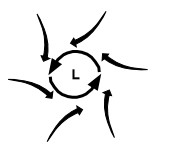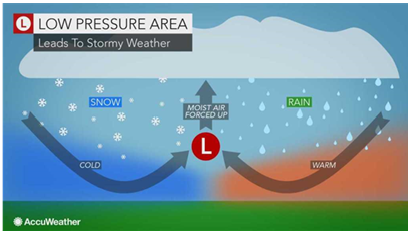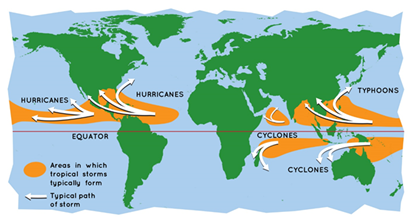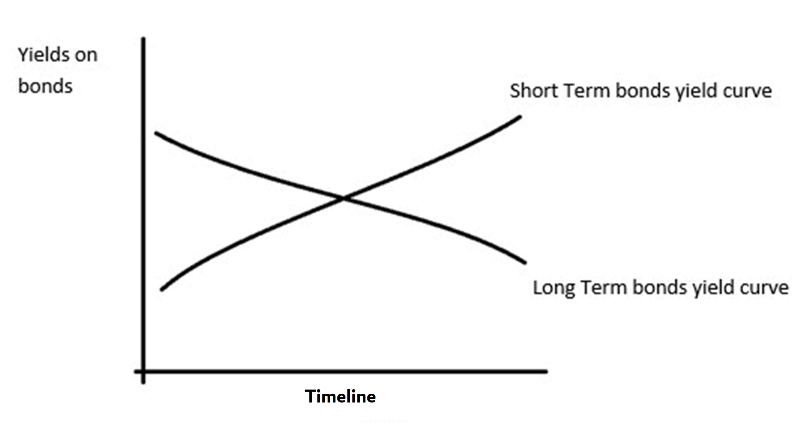Contents
- Low Pressure Area may intensify into Cyclonic Storm
- Repayment of GS2020
LOW PRESSURE AREA MAY INTENSIFY INTO CYCLONIC STORM
Focus: GS-I Geography, Prelims
Why in news?
- A Low-Pressure Area had formed over southeast Bay of Bengal and adjoining south Andaman Sea and it is very likely to concentrate into a Depression over central parts of south Bay of Bengal on May 15th and further intensify into a Cyclonic Storm over southwest and adjoining west-central Bay of Bengal by May 16th.
- Wind speed is likely to increase further becoming Gale force winds speed reaching 65-75 kmph gusting to 85 kmph.
- Fishermen are advised not to venture into South and Central Bay of Bengal.
How are Cyclones Formed?

- Tropical cyclones typically form over large bodies of relatively warm water. Warm water > Evaporation > Rising up of air > Low Pressure area.
- They derive their energy through the evaporation of water from the ocean surface, which ultimately re-condenses into clouds and rain when moist air rises and cools to saturation.
- Water takes up heat from the atmosphere to change into vapour.
- When water vapour changes back to liquid form as raindrops, this heat is released to the atmosphere.
- The heat released to the atmosphere warms the air around.
- The air tends to rise and causes a drop in the pressure.
- More air rushes to the centre of the storm.
- This cycle is repeated.
Why are Cyclones formed in a spiralling pattern?
- Simple answer is: Coriolis Effect.
- The Coriolis Effect causes any moving body on the rotating Earth to turn to the Right (clockwise) in the Northern Hemisphere and to the Left (counter clockwise) in the Southern Hemisphere.
- In Low-Pressure zones where air ascends, like in case of a cyclone, winds blowing from areas of high pressure inside towards areas of low pressure, are Deflected to the Right in Northern Hemisphere and to the Left in the Southern Hemisphere.
- Since they are deflected, they don’t arrive straight into the low-pressure zone, but instead end up circling around the low-pressure zone.

What is a Low-pressure area?
- A low-pressure area, low area or low is a region on the topographic map where the air pressure is lower than that of surrounding locations.
- Low-pressure systems form under areas of wind divergence that occur in the upper levels of the atmosphere.
- The formation process of a low-pressure area is known as cyclogenesis.
- Within the field of meteorology, atmospheric divergence aloft occurs in two areas.
- The first area is on the east side of upper troughs, which form half of a Rossby wave within the Westerlies (a trough with large wavelength that extends through the troposphere).
- A second area of wind divergence aloft occurs ahead of embedded shortwave troughs, which are of smaller wavelength.
- Diverging winds aloft ahead of these troughs cause atmospheric lift within the troposphere below, which lowers surface pressures as upward motion partially counteracts the force of gravity.
How are Low-Pressure Areas formed?

- Thermal lows form due to localized heating caused by greater sunshine over deserts and other land masses.
- Since localized areas of warm air are less dense than their surroundings, this warmer air rises, which lowers atmospheric pressure near that portion of the Earth’s surface.
- Large-scale thermal lows over continents help drive monsoon circulations.
- Low-pressure areas can also form due to organized thunderstorm activity over warm water.
Tropical cyclone
- A tropical cyclone is a rapidly rotating storm system characterized by a low-pressure center, a closed low-level atmospheric circulation, strong winds, and a spiral arrangement of thunderstorms that produce heavy rain or squalls.
- Depending on its location and strength, a tropical cyclone is referred to by different names:
- Cyclones in the Indian Ocean
- Hurricanes in the Atlantic
- Typhoons in the Western Pacific and the South China Sea
- Willy-willies in Western Australia

- “Tropical” refers to the geographical origin of these systems, which form almost exclusively over tropical seas.
- “Cyclone” refers to their winds moving in a circle, whirling round their central clear eye, with their winds blowing counterclockwise in the Northern Hemisphere and clockwise in the Southern Hemisphere.
- The opposite direction of circulation is due to the Coriolis effect.
REPAYMENT OF GS2020
Focus: GS-III Indian Economy, Prelims
Why in news?
Date for repayment of the outstanding balance under ’8.27% Government Security 2020’ was released.
What is a Government Security?
- A Government Security (G-Sec) is a Government Issued (Central or State) Tradeable Instrument.
- G-Sec is a debt obligation of the government to fund their fiscal deficit, i.e., it acknowledges the debt obligation of the Government (as to say that the government will pay back on maturity).
- There are two types of such securities:
- Short Term – Maturity period is less than one year, and they are usually called Treasury Bills (T-Bills).
- Long Term – Maturity period is more than one year, and they are usually called Government Bonds or Dated Securities.
- G-Secs practically do not carry the risk of defaulting; hence, they can be called risk-free gilt-edged instruments.
- Gilt-edged securities are high-grade investment bonds offered by governments and large corporations as a means of borrowing funds.
Government securities issued by Indian Government
The Indian Central Government issues both Short-term T-Bills and Long terms Government Bonds / dated securities called State Development Loans (SDL). It also issues other instruments which are not fully tradeable, like savings bonds, national saving certificate etc., or special securities like oil bonds, fertilizer bonds, etc.
Yield of G-Secs
The term yield denotes the benefit or interest-rate a G-Sec provides, i.e., the interest rate of the bond.
- Seeing the increased bond yield, more and more buying of the bonds will ensue leading to increased demand of the bonds and we know that increased demand will command a higher price.
- So, an increased demand will propel the bond prices up thereby leading to a reduction in bond yield, which will further lead to reduction in demand.





